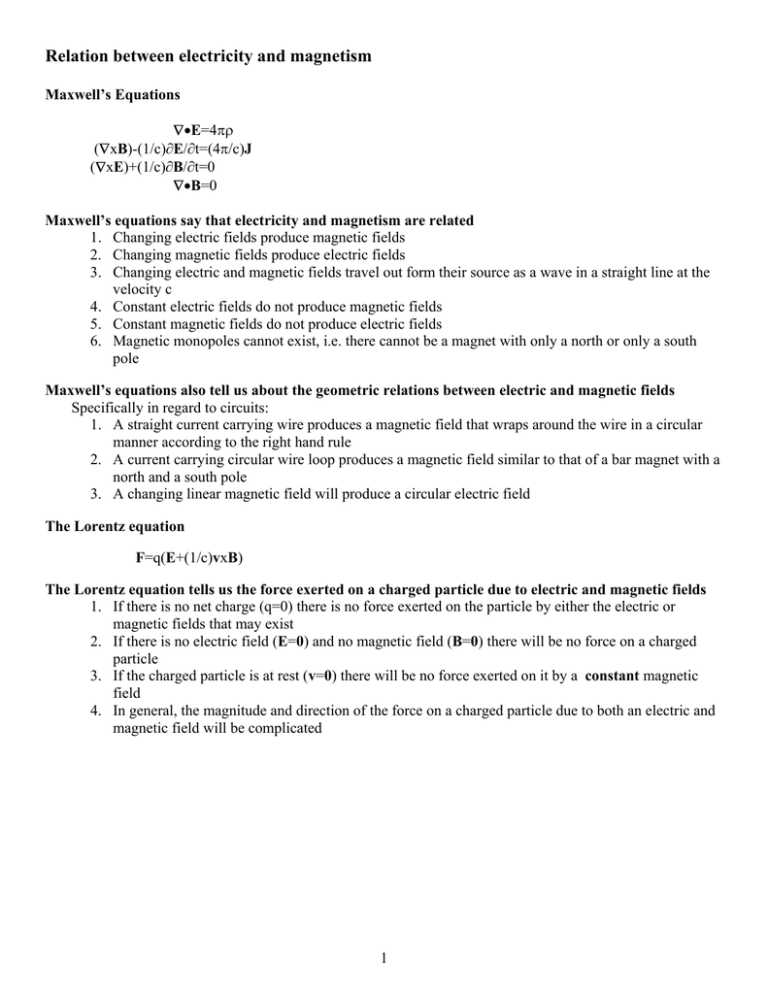Relation between electricity and magnetism
advertisement

Relation between electricity and magnetism Maxwell’s Equations ∇•E=4πρ (∇xB)-(1/c)∂E/∂t=(4π/c)J (∇xE)+(1/c)∂B/∂t=0 ∇•B=0 Maxwell’s equations say that electricity and magnetism are related 1. Changing electric fields produce magnetic fields 2. Changing magnetic fields produce electric fields 3. Changing electric and magnetic fields travel out form their source as a wave in a straight line at the velocity c 4. Constant electric fields do not produce magnetic fields 5. Constant magnetic fields do not produce electric fields 6. Magnetic monopoles cannot exist, i.e. there cannot be a magnet with only a north or only a south pole Maxwell’s equations also tell us about the geometric relations between electric and magnetic fields Specifically in regard to circuits: 1. A straight current carrying wire produces a magnetic field that wraps around the wire in a circular manner according to the right hand rule 2. A current carrying circular wire loop produces a magnetic field similar to that of a bar magnet with a north and a south pole 3. A changing linear magnetic field will produce a circular electric field The Lorentz equation F=q(E+(1/c)vxB) The Lorentz equation tells us the force exerted on a charged particle due to electric and magnetic fields 1. If there is no net charge (q=0) there is no force exerted on the particle by either the electric or magnetic fields that may exist 2. If there is no electric field (E=0) and no magnetic field (B=0) there will be no force on a charged particle 3. If the charged particle is at rest (v=0) there will be no force exerted on it by a constant magnetic field 4. In general, the magnitude and direction of the force on a charged particle due to both an electric and magnetic field will be complicated 1 Magnetic Induction Calculating magnetic flux Φ=A•B Magnetic flux Specifically with regard to a circuit loop: 1. Magnetic flux through a loop depends on the area enclosed by the loop and the strength and direction of the magnetic field through the loop 2. Magnetic flux is often thought of in terms of magnetic flux lines a. Magnetic flux lines travel in the direction of the magnetic field lines b. The stronger the magnetic field is in a given area, the greater the number of flux lines in that area Faraday’s Law: magnetic induction EMF=-dΦ/dt Faraday’s Law says that a changing magnetic flux will “induce” an electromotive force (electric field) Specifically with regard to a conducting circuit loop: 1. A changing magnetic flux through the loop will induce an electromotive force on the charges in the wire of the loop thereby producing an electric current to flow around the loop 2. According to Lens’ Law the induced current will flow in such a way as to oppose the change in magnetic flux (use the right hand rule) Consequences of magnetic induction 1. The solenoid a. A solenoid is many loops of wire wrapped tightly into the shape of a cylinder b. When current flows through the wire composing the solenoid the magnetic fields of all the loops add to produce a strong magnetic field c. The resultant magnetic field resembles the magnetic field of a bar magnet with a north and a south pole d. Solenoids are used in many electronic devices 2. The electromagnet a. An electromagnet is basically a solenoid with a ferromagnetic rod (usually made of iron) through it b. Because of its molecular properties the ferromagnetic rod intensifies the strength of the magnetic field produced by the solenoid 3. Magnetic sensors a. Devices can be made that detect and/or amplify the electric fields induced by changing magnetic fields b. One example is an audio cassette tape 4. Transformers: 2 solenoids and mutual inductance a. The current flowing through one solenoid will produce a magnetic field which will induce a current to flow in a second, nearby solenoid effectively “transforming” the current of the first solenoid into a current in the second solenoid b. Mutual inductance is a measure of how the magnetic fields produced by 2 (or possibly more) solenoids will effect the current produced in the other(s) c. Mutual inductance depends on the ratio of the number of loops in one solenoid to the number of loops in the other solenoid 2 5. Generators Mechanical work is used to produce changing magnetic fields which are then used to “generate” electric current (AC) 6. Engines Electric current (AC) is used to produce changing magnetic fields which are then used to produce mechanical work Calculating the efficiency of an engine ℇ=Wout/Ein Efficiency 1. The efficiency, ℇ, of an engine is defined to be the ratio of the useful work created, Wout, to the energy put in, Ein. 2. An engine with an efficiency equal to 1 is ideal and impossible to achieve in practice due to friction. 3






